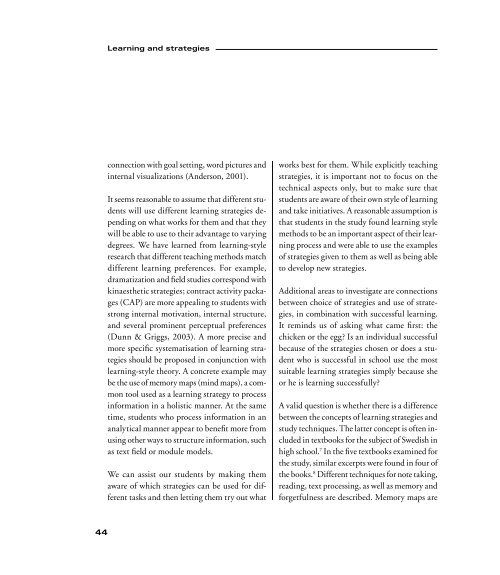Tidskrift för lärarutbildning och forskning 4/2005
Tidskrift för lärarutbildning och forskning 4/2005
Tidskrift för lärarutbildning och forskning 4/2005
Create successful ePaper yourself
Turn your PDF publications into a flip-book with our unique Google optimized e-Paper software.
Learning and strategies<br />
connection with goal setting, word pictures and<br />
internal visualizations (Anderson, 2001).<br />
It seems reasonable to assume that different students<br />
will use different learning strategies depending<br />
on what works for them and that they<br />
will be able to use to their advantage to varying<br />
degrees. We have learned from learning-style<br />
research that different teaching methods match<br />
different learning preferences. For example,<br />
dramatization and field studies correspond with<br />
kinaesthetic strategies; contract activity packages<br />
(CAP) are more appealing to students with<br />
strong internal motivation, internal structure,<br />
and several prominent perceptual preferences<br />
(Dunn & Griggs, 2003). A more precise and<br />
more specific systematisation of learning strategies<br />
should be proposed in conjunction with<br />
learning-style theory. A concrete example may<br />
be the use of memory maps (mind maps), a common<br />
tool used as a learning strategy to process<br />
information in a holistic manner. At the same<br />
time, students who process information in an<br />
analytical manner appear to benefit more from<br />
using other ways to structure information, such<br />
as text field or module models.<br />
We can assist our students by making them<br />
aware of which strategies can be used for different<br />
tasks and then letting them try out what<br />
works best for them. While explicitly teaching<br />
strategies, it is important not to focus on the<br />
technical aspects only, but to make sure that<br />
students are aware of their own style of learning<br />
and take initiatives. A reasonable assumption is<br />
that students in the study found learning style<br />
methods to be an important aspect of their learning<br />
process and were able to use the examples<br />
of strategies given to them as well as being able<br />
to develop new strategies.<br />
Additional areas to investigate are connections<br />
between choice of strategies and use of strategies,<br />
in combination with successful learning.<br />
It reminds us of asking what came first: the<br />
chicken or the egg Is an individual successful<br />
because of the strategies chosen or does a student<br />
who is successful in school use the most<br />
suitable learning strategies simply because she<br />
or he is learning successfully<br />
A valid question is whether there is a difference<br />
between the concepts of learning strategies and<br />
study techniques. The latter concept is often included<br />
in textbooks for the subject of Swedish in<br />
high school. 7 In the five textbooks examined for<br />
the study, similar excerpts were found in four of<br />
the books. 8 Different techniques for note taking,<br />
reading, text processing, as well as memory and<br />
forgetfulness are described. Memory maps are<br />
44

















